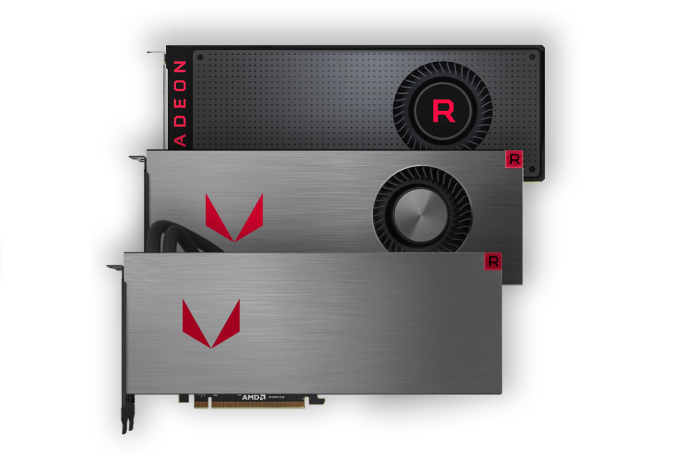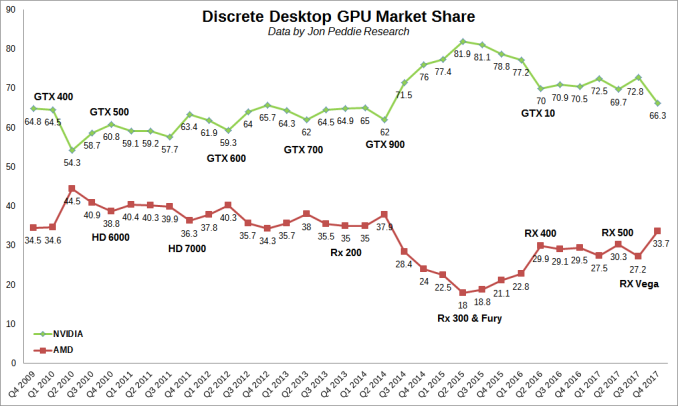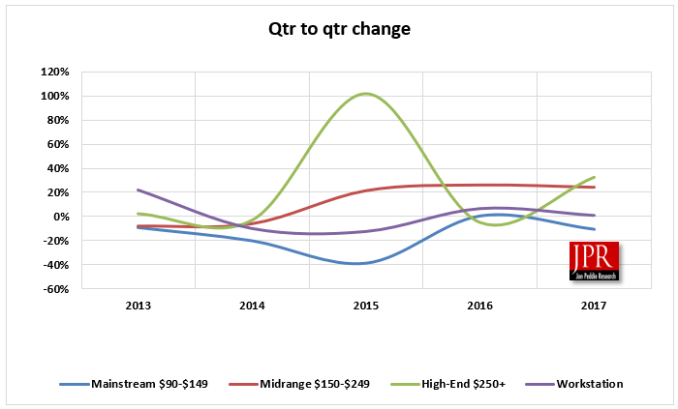Cryptomining Inflated Prices Affect Q4 2017 Discrete Graphics Card Shipments, AMD Climbs to 33.7% Market Share
by Nate Oh on March 1, 2018 9:00 AM EST
This week, Jon Peddie Research (JPR) released their much anticipated quarterly discrete video card sales report for Q4 2017.
Overall, the research firm is reporting a 4.6% decrease in graphics add-in board (AIB) shipments from last quarter. According to JPR, this is in line with their seasonal ten-year Q3-to-Q4 average of -4.4%; and yet despite this, Q4 was hardly a normal quarter in the industry. As many long-time readers are already well aware, Q4 is when GPU cyrptocurrency mining came back with a vengeance, and indeed without mincing words, the report attributed Q4 2017’s figures to a combination of cryptocurrency mining demand inflating average selling prices, as well as seasonality.
Interestingly it's arguably the latter point that's the more salient. While cryptocurrency prices have affected prices, the long ramp-up/ramp-down cycle for beginning-to-end video card production means that the industry can't radically alter volumes inside a single quarter. In other words, GPU manufacturers and their partners have to plan for the quarter in advance, and a typical Q4 plan would involve tapering back on production a bit to match the traditional seasonal demand.
In total, JPR estimates that over three million graphics cards were sold to cryptocurrency miners, adding up to $776 million in sales. Of these sales, AMD benefitted the most - as one might expect from their early performance advantage in cryptocurrency mining performance. As a result, AMD’s discrete desktop graphics market share is up 6.5 percentage points from Q3 2017, increasing to 33.7%, while NVIDIA’s stands at 66.3%.
| Discrete Desktop GPU Market Share Data by Jon Peddie Research |
|||||
| Q4'2017 | Q3'2017 | Q4'2016 | |||
| AMD | 33.7% | 27.2% | 29.5% | ||
| NVIDIA | 66.3% | 72.8% | 70.5% | ||
In the public report, it was not specified how much of the market share change was attributable to disproportionate mining sales. Nevertheless, this brings AMD’s share to the highest it has been since Q2 2014. Including all desktop and notebook GPUs, market share remains fairly similar to last quarter, with AMD picking up 1.2%, Intel down 0.4%, and NVIDIA down 0.9%. AMD’s overall GPU shipments were up 8.08% from last quarter, while Intel’s total shipments were down 1.98% and NVIDIA’s down 6%.
| Total GPU Market Share Data by Jon Peddie Research |
|||||
| Q4'2017 | Q3'2017 | Q4'2016 | |||
| AMD | 14.2% | 13.0% | 14.4% | ||
| Intel | 67.4% | 67.8% | 68.1% | ||
| NVIDIA | 18.4% | 19.3% | 17.5% | ||
| Change in GPU Unit Shipments by Segment Data by Jon Peddie Research |
||||
| Quarterly Change | Annual Change | |||
| Discrete Desktop | -4.6% | 9.7% | ||
| Desktop Integrated and Embedded | 3.0% | -8.3% | ||
| Desktop Total | -0.1% | -2.1% | ||
| Discrete Notebook | 3.6% | -5.6% | ||
| Notebook Integrated and Embedded | -3.7% | -6.8% | ||
| Notebook Total | -2.3% | -6.5% | ||
| All Total | -1.45% | -4.8% | ||
JPR did note that the high-end ($250+) and mid-range ($150 – 249) segments continue to expand, while the lower-end mainstream ($90 – 149) stagnates. Though not part of the report itself, this trend is consistent with higher-end cards being favored for mining due to better performance per watt and per dollar. At the same time there's some natural pressure as well: as integrated graphics capabilities improve, this trend is likely to persist. Just last month AMD released their new generation of APUs, with graphics performance of the Ryzen 5 2400G on par with the entry-level discrete graphics.
| Graphics Segment Market Share Data by Jon Peddie Research |
||||
| Q4'2017 | Q4'2016 | |||
| Mainstream ($90 - $149) | 26.1% | 39.2% | ||
| Mid-range ($150 - $249) | 51.7% | 41.5% | ||
| High-end ($250+) | 16.0% | 11.5% | ||
| Workstation | 6.3% | 7.8% | ||
As far as cryptomining demand goes, JPR expects the tapering off to continue, and otherwise remain volatile, an outlook similar to those of both NVIDIA and AMD. However, JPR warns that “[inflated AIB] prices will not drop in the near future.” The decline has not been straightforward, and NVIDIA stated for their recent quarterly report that cryptomining contributed more to revenue than last quarter on a percentage basis; in context, NVIDIA had accounted cryptomining board sales to total to around $70 million for fiscal Q3 2018 and $150 million for fiscal Q2. Compounding matters is the ongoing GDDR5/HBM2 memory shortage, which is further bottlenecking video card production.
In their respective quarterly financial calls, both GPU vendors reiterated their focus on consumer gaming over cryptocurrency mining. Though ultimately neither vendor has the ability to completely restrict sales to a single group due to the nature of the open market.
Source: Jon Peddie Research












51 Comments
View All Comments
HStewart - Thursday, March 1, 2018 - link
"It's pretty simple. Every GPU you can buy generates money. People like money. "Well I think this stuff will burst one day, when people realize it not real money - but generated by GPU. It got to have real value backing it. So if demand is based on it - this demand is imaginary and once it burst, people will excess machines hat do nothing
Maybe one could give them to their kids to play games.
BenSkywalker - Thursday, March 1, 2018 - link
Cryptocurrency is a fiat currency, it has nothing backing it besides what people think it's worth.Other notable fiat currencies are the Euro and the U.S. Dollar.
willis936 - Thursday, March 1, 2018 - link
Uhh what cryptocurrecies are you looking at that are fiat? Fiat are what they replace.willis936 - Thursday, March 1, 2018 - link
Yeah it's 4%... in a quarter. In the past 10 years AMD has only seen positive change in market share that fast in Q1 2016 and Q1 2010. So yes it is something that raises eyebrows.HStewart - Thursday, March 1, 2018 - link
Keep in mind that 4% of 33% of entire market - so that like 1.3% or total mark and with Crypto stuff - a lot of that wasted and when Crypto stuff busted as it surely will one day, it will be all wasted.forgerone - Thursday, March 1, 2018 - link
Everybody is ignoring the obvious.Neither AMD nor nVidia has ANY control over how OEM's sell they GPU AIB cards. All both companies do is fabricate GPU's and sell them to Add in Board makers. And the OEM's just want to sell product. They do not give a hoot about gamers.
The only way for AMD to give gamers a high performance GPU is to put it in a package with an 8 core Ryzen CPU. This is what they did by giveing Intel Vega chiplets for Kaby-G.
AMD could also do this for miners by using a cheap 4 core CPU along with say 2 Vega GPU chiplets along with HBM2 in a single APU package. That would be good for maybe 100 megahashes per second.
It would also cut the legs off the GPU AIB OEM's.
msroadkill612 - Wednesday, March 7, 2018 - link
Its fun to speculate, but its not too hard to guess where amd are going from the foundations they have laid over 2017 - the apu was the grand finale.They are not made of money and have to use that excellent foundation.
they have a platform for one die, with 2 processor units, which may both be cpuS, or now, a cpu unit and a gpu unit (apu).
Next they have TR4 platform for 2x 2 cpu only processor dies as above.
It seems quite possible they could simply use 2x apu die as above on the tr4 platform, to yield 2x vega and 8x cores, but I dont think so - too expensive for a perceived (arguable imo -an apu workstation?) entry level rig.
The presence of video ports on am4 mobos almost a year before apuS hit the shelves, clearly announced am4 was to be the apu platform.
Its fundamental to amd zen architecture that the basic cpu unit (the 4 core ccx), be 4 core.
It allows each core to link to any other core in one step. Going beyond 4 cores would disrupt the whole architecture.
IMO, You will only see single die ~am4 apus for some time, and you can only have one 4 core ccx and one gpu on am4.
A modified tr4 mobo with graphics ports is possible for more cpu & gpu cores, and double memory bandwidth - a boon for apuS.
mode_13h - Sunday, March 11, 2018 - link
This won't happen. People in that price segment will buy discrete GPUs, which are a much more cost-effective way of adding compute & memory bandwidth. The DDR4 supported by ThreadRipper and EPYC's socket can't begin to compete with GDDR5 or HBM2, and the coolers for that socket can't dissipate enough heat.Dragonstongue - Thursday, March 1, 2018 - link
yeh because they know for a fact that 3m+ graphics cards went to miners and miners alone, what about every other sector of the market who buys them, maybe individuals all decided to upgrade at once in the 4Q, or maybe the "data" about sales came through in 4Q from massive backorders.Easy to pick a simple "reason" because that is the word of the year "miners are screwing us all over" what about "pro users" who see these awesome performance gaming cards and convinced their bosses, financial institutions, school CAD workshops etc, nope, it is ONLY miners that bought every single one of those multi million dollars worth of inventory
(I call major BS on that theory. yes there is some massive mining farms (many of which no longer use GPU because FPGA/ASIC are far more cost effective and higher performing..not ALL coins can be mined properly with them, that is a given.
yes it is an "issue" but is also making a mountain out of a molehill IMO..awesome products throughout 2016-2017 with ram shortages, not enough flash memory available etc etc..
one problem easily stacks on another, if MSI as an example only "ordered" x thousands of units and they were selling instantly when there is only X total chips off each wafer, does not automatically mean specific corners of the market are the buyers, unless JPR has access to look at credit card bills and walk into everywhere that bought them, it is a gross assumption at best.
I call this clickbait article from JPR (like barnes, and I cannot tell you how many other usually investor sites spitting all kinds of BS just because some certain mass media do the same damn thing)
they track "sales" but JPR does not have access to ALL the selling information from AMD, Intel, Nvidia etc, very much like the "age of the universe" theorists, they take one iota of information no matter how obtuse and "play the numbers"
Years ago Intel, AMD, Nvidia to name a few of the larger tech companies announced they were STOPPING 3rd party "sales figures" because it was detrimental to their business operations, so either this "number" they are using is bloated, or they are piecing together BS figures from many places and compounding the data.
Not first time miners are blamed for this, I guess we might as well blame "business" for ludicrous things such as Windows 10 being the way that it is because "they screwed the casual user and gamer alike"
Hurr Durr - Friday, March 2, 2018 - link
You were right to put pro users in quotation marks. Real professional will never buy an overpgiced gaming GPU when cheaper Quadro can run what's needed two times faster.